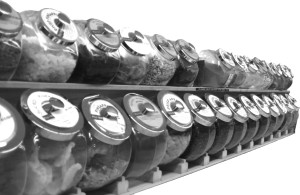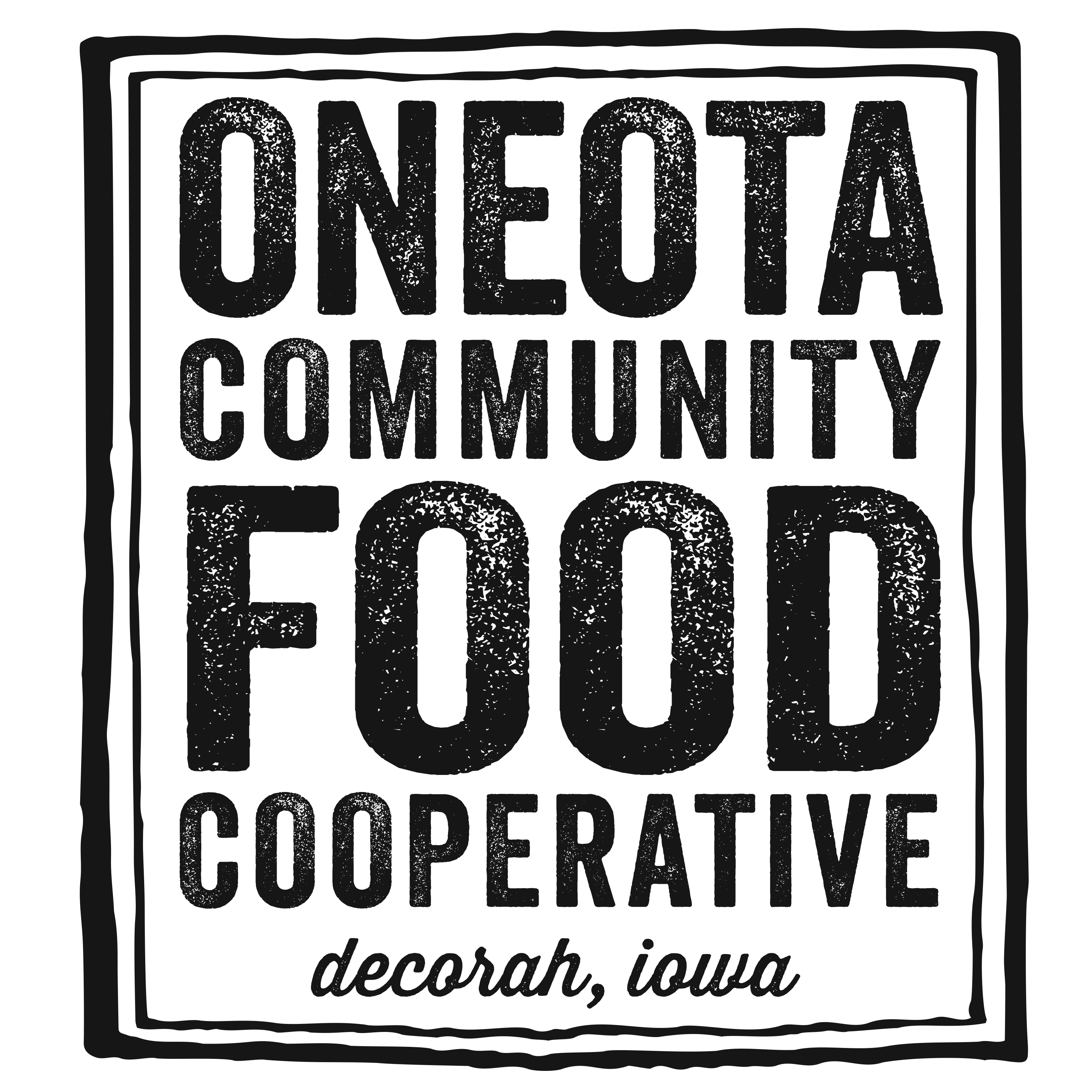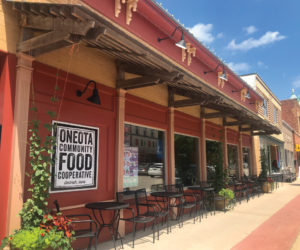

By: Carl Haakenstad, Bulk Buyer
To many long-time Co-op shoppers the Bulk department is thought of as the heart of the Co-op and has been since the Co-op’s founding in 1974. After all, the beginning of Oneota Co-op was primarily about pooling resources to buy product in bulk quantities and then split them between the individuals in the group.
These days Oneota is attracting additional new shoppers, many of whom may not understand how Bulk shopping works and what the benefits are to shopping in this department. For this reason I thought I would give you a little background on how the Bulk department operates and why it is a good part of the store to shop in. Let’s start with the basics of how to shop in the Bulk department.
Bag it & Tag it
When you have found a bulk product you want to purchase, you must first decide if you want to put it in a bag, plastic container, or a container that you brought from home. (I will cover the container from home a little later).
Shopping in Bulk with a container from the Co-op can seem complicated, but it is actually quite simple and can be summed up by the simple phrase “Bag It and Tag It.”
Obviously, some things work better in bags than others. Flour and oats work great in a bag, but I would steer clear of peanut butter in a bag. Let’s say you are getting some rolled oats. You will grab a paper or plastic bag provided at the Co-op Bulk department and then scoop the oats into your chosen bag. You can take as much oats as you want or as little as you want – which illustrates another beautiful aspect of shopping bulk. For example, if you want only enough oats for a cookie recipe, we provide measuring cups so you can buy only a half cup – or whatever measurement you need.
Once you have the amount of oats you want, all you need to do is write down the PLU (Product Look Up) number of the item you are purchasing on the container. The easiest way to do this is to write the number on the thick white twist ties that are available throughout the Bulk department. Simply write the corresponding number from the bin on the twist tie and seal your bag with it. If you are getting something in a plastic container, you can write the PLU number on small white stickers that we provide in the Bulk department. We also provide masking tape for sealing and writing on if you like – which works great for paper bags.
We also provide a scale in the Bulk department in case you want to see how much of a product you have in your bag or container. However, you do not need to weigh it yourself once you have it packaged because our cashiers will take care of that for you at the checkout.
See, bag it and tag it. It’s that simple. 
Weigh It, Fill It, Tag It
You can also bring containers from home to fill with product from the Bulk department. For example, think mason jars, Ziploc bags, large Tupperware containers, or any clean container you want to use. If you bring your own container, you will want to make sure to weigh it before you put any new product into it. This empty weight is called the tare weight. Our cashiers need to know this weight so they only charge you for the product you are putting into the container. Think of it like the farmer who is taking grain to the local elevator. He or she has to weigh the tractor and wagon first when empty because the elevator doesn’t want to pay them for the weight of the tractor and wagon, just the grain.
When you pre-weigh your container, you will need to write down the weight either on a piece of masking tape adhered to the container, or on a piece of scratch paper that you give to the cashier at the checkout. After that simply fill your container with bulk food and write down the PLU number. If you get confused while you are in the Bulk department, a staff member should be nearby. We are always glad to give you an explanation or help you fill your container. Just ask, we are here to help.
As a long-time Bulk shopper, my tip for new Bulk shoppers would be to buy products off the grocery shelves and then use the containers to shop for comparable items in bulk after you run out. You can take your olive oil bottle and refill it with bulk olive oil and your jar of cinnamon and refill it with Bulk cinnamon. (Just remember to weigh your container before you start to fill it with new product.)
Why?
Now that we have the basics covered of how to shop in Bulk we should cover the “why” to shop Bulk. One of the best things about shopping in bulk is being able to see exactly what you are getting. When buying packaged foods, you often can’t see the product inside the package until you open it at home. We are even happy to give you a sample – if you ask.
There are also environmental benefits to shopping in the Bulk department. The main environmental benefit being reduced packaging. If you buy bulk granola in a thin plastic or paper bag instead of a cardboard box off the shelf, you have saved the energy needed to make and recycle the box. Kick it up a notch. If you bring a container from home and fill it with granola, you have saved even more packaging and energy use.
Recently, the Bulk department has been selling more items that are re-packed (items that come in bulk but we pre-package for the customer). Even if we pre-pack items in a clear plastic container, we are still eliminating the need for lots of inks, dyes and extra layers of packaging needed for the normal packaging you find in the grocery aisle.
Let’s get back to another great benefit to shopping Bulk – the ability to buy as much or as little as you want. If you are buying packaged goods, you often only have two size options: small box and large box. In the Bulk department you can buy a quarter pound (or less) of something or you can buy ten pounds (or more). It is up to you. When you buy only what you need, you are less likely to waste food and money by having the product go bad before you use it.
The Bulk department is also full of foods that are healthy because they are less processed, or, in some cases, still raw. Don’t get me wrong, we do have plenty of great snacks and candy in the Bulk department too. However, most of the department features food like whole grains, nuts, legumes, and dried fruits. These foods, in their single ingredient form, oftentimes mean more work in the kitchen. But this also usually leads to great health benefits by deciding for yourself precisely what goes into the items you are eating. Items like salt, MSG and other flavor enhancers or preservatives are not items found in single-ingredient product in the Bulk department.
Looking for another reason to do more from-scratch cooking at home? A study released in 2014 by Julia Wolfson and Sara Bleich at the Johns Hopkin Bloomberg School of Public Health found that individuals who cooked and ate home-cooked meals more often consumed fewer calories as a whole – including less overall fat and sugar. The study looked at data from adults aged 20 years and over from the 2007-2010 National Health and Nutrition Examination Survey.
Cooking at home is also a great way to pass along valuable kitchen skills to your kids. If you don’t feel confident in your cooking skills yet, you should take one of the many cooking classes offered through the Co-op – see page 6 of this publication.
As with many decisions, shopping patterns often come down to price and affordability. By allowing us to buy in larger, less package-intensive quantities and sell it to you in the quantity that is right for you, shopping the Bulk department can make organic and natural foods more affordable as well. Our bulk and packaged products often come from the same source, but flashy and plentiful packaging usually comes with a higher price.
Now that you know the benefits of shopping the bulk department I hope to see you amidst the bins and scoops. If you have questions about bulk shopping, feel free to approach me or one of Oneota’s fine employees. We’ll be happy to assist you.



